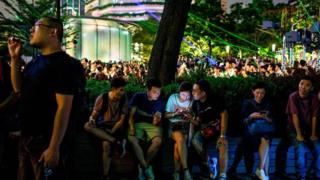 Image copyright
Image copyright
Getty Images
In late July, Hong Kong protesters getting back from an illustration had been attacked by a bunch of males sporting white shirts. Soon afterwards, nameless adverts appeared on-line calling for a mass Pokemon Go hunt in a city the place the suspected attackers had congregated per week earlier.
“If we said that we were going to an unauthorised protest it would have provided good evidence for the police to charge us,” mentioned KK, an workplace employee and protester in his late 20s, who requested for his identification to be protected.
Thousands of protesters gathered on the location, recognising that the online game – which lets gamers pit digital monsters towards one another at real-world places – had been used as a manner to collect individuals collectively for a really totally different sort of battle.
Crowds had been finally dispersed with tear fuel as police and protesters clashed into the late night.
“Many people think of creative ways to gather people,” KK added.
“We will occasionally ‘play’ Pokemon Go, or take part in ‘Bible reading groups’ or ‘history tours’.”
AirDrop used to share protest particulars
Mass demonstrations towards a now-suspended extradition invoice began in Hong Kong within the spring. Among the protesters’ calls for are amnesty for anybody arrested through the demonstrations and higher selection in future elections held within the semi-autonomous metropolis.
And they’re are discovering more and more artistic methods to organise and stage their rallies.
Maps selling Pokemon Go occasions function a manner to flag the place protests will probably be held
From chats on the personal messaging app Telegram to Uber’s ride-hailing service, apps have develop into an integral a part of the best way that Hong Kong’s youth-led motion is organised.
On packed subways, protesters anonymously ship freshly-designed posters by way of Apple’s wi-fi and Bluetooth-based file-transfer facility AirDrop – to share occasions and places.
“At the very early stage of the movement, Telegram was mostly used to spread information to protesters,” mentioned Rob, a college graduate and lively protester in his 20s.
“Information typically included real-time locations of the police force, the situations at different front lines on different streets and locations of first aid stations, gas masks, goggles, bottles of water.”
Now, he defined, it’s ceaselessly used to place orders for Uber pick-ups. The drivers disable their GPS (world positioning system) receivers to keep away from being tracked as they provide rides residence to protesters who want to depart the scene.
This on-line poster calls…
https://www.bbc.co.uk/news/technology-49280726
